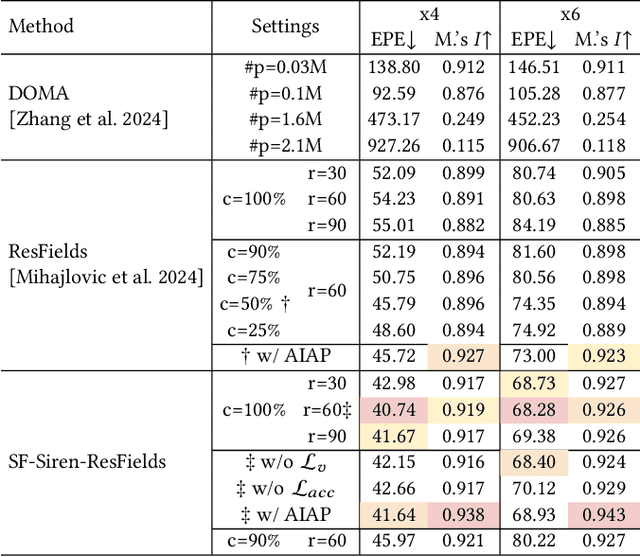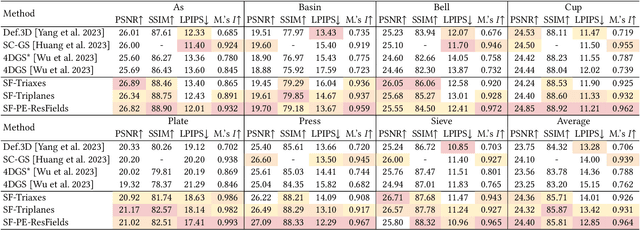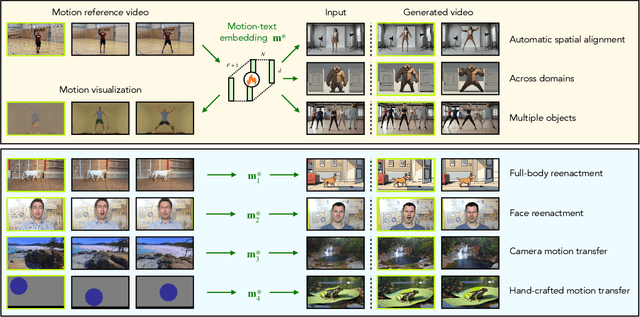Markus Gross
Spline Deformation Field
Jul 10, 2025



Abstract:Trajectory modeling of dense points usually employs implicit deformation fields, represented as neural networks that map coordinates to relate canonical spatial positions to temporal offsets. However, the inductive biases inherent in neural networks can hinder spatial coherence in ill-posed scenarios. Current methods focus either on enhancing encoding strategies for deformation fields, often resulting in opaque and less intuitive models, or adopt explicit techniques like linear blend skinning, which rely on heuristic-based node initialization. Additionally, the potential of implicit representations for interpolating sparse temporal signals remains under-explored. To address these challenges, we propose a spline-based trajectory representation, where the number of knots explicitly determines the degrees of freedom. This approach enables efficient analytical derivation of velocities, preserving spatial coherence and accelerations, while mitigating temporal fluctuations. To model knot characteristics in both spatial and temporal domains, we introduce a novel low-rank time-variant spatial encoding, replacing conventional coupled spatiotemporal techniques. Our method demonstrates superior performance in temporal interpolation for fitting continuous fields with sparse inputs. Furthermore, it achieves competitive dynamic scene reconstruction quality compared to state-of-the-art methods while enhancing motion coherence without relying on linear blend skinning or as-rigid-as-possible constraints.
IPFormer: Visual 3D Panoptic Scene Completion with Context-Adaptive Instance Proposals
Jun 25, 2025Abstract:Semantic Scene Completion (SSC) has emerged as a pivotal approach for jointly learning scene geometry and semantics, enabling downstream applications such as navigation in mobile robotics. The recent generalization to Panoptic Scene Completion (PSC) advances the SSC domain by integrating instance-level information, thereby enhancing object-level sensitivity in scene understanding. While PSC was introduced using LiDAR modality, methods based on camera images remain largely unexplored. Moreover, recent Transformer-based SSC approaches utilize a fixed set of learned queries to reconstruct objects within the scene volume. Although these queries are typically updated with image context during training, they remain static at test time, limiting their ability to dynamically adapt specifically to the observed scene. To overcome these limitations, we propose IPFormer, the first approach that leverages context-adaptive instance proposals at train and test time to address vision-based 3D Panoptic Scene Completion. Specifically, IPFormer adaptively initializes these queries as panoptic instance proposals derived from image context and further refines them through attention-based encoding and decoding to reason about semantic instance-voxel relationships. Experimental results show that our approach surpasses state-of-the-art methods in overall panoptic metrics PQ$^\dagger$ and PQ-All, matches performance in individual metrics, and achieves a runtime reduction exceeding 14$\times$. Furthermore, our ablation studies reveal that dynamically deriving instance proposals from image context, as opposed to random initialization, leads to a 3.62% increase in PQ-All and a remarkable average improvement of 18.65% in combined Thing-metrics. These results highlight our introduction of context-adaptive instance proposals as a pioneering effort in addressing vision-based 3D Panoptic Scene Completion.
Efficient Correlation Volume Sampling for Ultra-High-Resolution Optical Flow Estimation
May 22, 2025Abstract:Recent optical flow estimation methods often employ local cost sampling from a dense all-pairs correlation volume. This results in quadratic computational and memory complexity in the number of pixels. Although an alternative memory-efficient implementation with on-demand cost computation exists, this is slower in practice and therefore prior methods typically process images at reduced resolutions, missing fine-grained details. To address this, we propose a more efficient implementation of the all-pairs correlation volume sampling, still matching the exact mathematical operator as defined by RAFT. Our approach outperforms on-demand sampling by up to 90% while maintaining low memory usage, and performs on par with the default implementation with up to 95% lower memory usage. As cost sampling makes up a significant portion of the overall runtime, this can translate to up to 50% savings for the total end-to-end model inference in memory-constrained environments. Our evaluation of existing methods includes an 8K ultra-high-resolution dataset and an additional inference-time modification of the recent SEA-RAFT method. With this, we achieve state-of-the-art results at high resolutions both in accuracy and efficiency.
LookingGlass: Generative Anamorphoses via Laplacian Pyramid Warping
Apr 11, 2025Abstract:Anamorphosis refers to a category of images that are intentionally distorted, making them unrecognizable when viewed directly. Their true form only reveals itself when seen from a specific viewpoint, which can be through some catadioptric device like a mirror or a lens. While the construction of these mathematical devices can be traced back to as early as the 17th century, they are only interpretable when viewed from a specific vantage point and tend to lose meaning when seen normally. In this paper, we revisit these famous optical illusions with a generative twist. With the help of latent rectified flow models, we propose a method to create anamorphic images that still retain a valid interpretation when viewed directly. To this end, we introduce Laplacian Pyramid Warping, a frequency-aware image warping technique key to generating high-quality visuals. Our work extends Visual Anagrams (arXiv:2311.17919) to latent space models and to a wider range of spatial transforms, enabling the creation of novel generative perceptual illusions.
Bridging the Gap between Gaussian Diffusion Models and Universal Quantization for Image Compression
Apr 03, 2025Abstract:Generative neural image compression supports data representation at extremely low bitrate, synthesizing details at the client and consistently producing highly realistic images. By leveraging the similarities between quantization error and additive noise, diffusion-based generative image compression codecs can be built using a latent diffusion model to "denoise" the artifacts introduced by quantization. However, we identify three critical gaps in previous approaches following this paradigm (namely, the noise level, noise type, and discretization gaps) that result in the quantized data falling out of the data distribution known by the diffusion model. In this work, we propose a novel quantization-based forward diffusion process with theoretical foundations that tackles all three aforementioned gaps. We achieve this through universal quantization with a carefully tailored quantization schedule and a diffusion model trained with uniform noise. Compared to previous work, our proposal produces consistently realistic and detailed reconstructions, even at very low bitrates. In such a regime, we achieve the best rate-distortion-realism performance, outperforming previous related works.
How I Warped Your Noise: a Temporally-Correlated Noise Prior for Diffusion Models
Apr 03, 2025Abstract:Video editing and generation methods often rely on pre-trained image-based diffusion models. During the diffusion process, however, the reliance on rudimentary noise sampling techniques that do not preserve correlations present in subsequent frames of a video is detrimental to the quality of the results. This either produces high-frequency flickering, or texture-sticking artifacts that are not amenable to post-processing. With this in mind, we propose a novel method for preserving temporal correlations in a sequence of noise samples. This approach is materialized by a novel noise representation, dubbed $\int$-noise (integral noise), that reinterprets individual noise samples as a continuously integrated noise field: pixel values do not represent discrete values, but are rather the integral of an underlying infinite-resolution noise over the pixel area. Additionally, we propose a carefully tailored transport method that uses $\int$-noise to accurately advect noise samples over a sequence of frames, maximizing the correlation between different frames while also preserving the noise properties. Our results demonstrate that the proposed $\int$-noise can be used for a variety of tasks, such as video restoration, surrogate rendering, and conditional video generation. See https://warpyournoise.github.io/ for video results.
Spline-based Transformers
Apr 03, 2025Abstract:We introduce Spline-based Transformers, a novel class of Transformer models that eliminate the need for positional encoding. Inspired by workflows using splines in computer animation, our Spline-based Transformers embed an input sequence of elements as a smooth trajectory in latent space. Overcoming drawbacks of positional encoding such as sequence length extrapolation, Spline-based Transformers also provide a novel way for users to interact with transformer latent spaces by directly manipulating the latent control points to create new latent trajectories and sequences. We demonstrate the superior performance of our approach in comparison to conventional positional encoding on a variety of datasets, ranging from synthetic 2D to large-scale real-world datasets of images, 3D shapes, and animations.
High-Fidelity Novel View Synthesis via Splatting-Guided Diffusion
Feb 18, 2025



Abstract:Despite recent advances in Novel View Synthesis (NVS), generating high-fidelity views from single or sparse observations remains a significant challenge. Existing splatting-based approaches often produce distorted geometry due to splatting errors. While diffusion-based methods leverage rich 3D priors to achieve improved geometry, they often suffer from texture hallucination. In this paper, we introduce SplatDiff, a pixel-splatting-guided video diffusion model designed to synthesize high-fidelity novel views from a single image. Specifically, we propose an aligned synthesis strategy for precise control of target viewpoints and geometry-consistent view synthesis. To mitigate texture hallucination, we design a texture bridge module that enables high-fidelity texture generation through adaptive feature fusion. In this manner, SplatDiff leverages the strengths of splatting and diffusion to generate novel views with consistent geometry and high-fidelity details. Extensive experiments verify the state-of-the-art performance of SplatDiff in single-view NVS. Additionally, without extra training, SplatDiff shows remarkable zero-shot performance across diverse tasks, including sparse-view NVS and stereo video conversion.
Monocular Facial Appearance Capture in the Wild
Dec 17, 2024



Abstract:We present a new method for reconstructing the appearance properties of human faces from a lightweight capture procedure in an unconstrained environment. Our method recovers the surface geometry, diffuse albedo, specular intensity and specular roughness from a monocular video containing a simple head rotation in-the-wild. Notably, we make no simplifying assumptions on the environment lighting, and we explicitly take visibility and occlusions into account. As a result, our method can produce facial appearance maps that approach the fidelity of studio-based multi-view captures, but with a far easier and cheaper procedure.
Reenact Anything: Semantic Video Motion Transfer Using Motion-Textual Inversion
Aug 01, 2024



Abstract:Recent years have seen a tremendous improvement in the quality of video generation and editing approaches. While several techniques focus on editing appearance, few address motion. Current approaches using text, trajectories, or bounding boxes are limited to simple motions, so we specify motions with a single motion reference video instead. We further propose to use a pre-trained image-to-video model rather than a text-to-video model. This approach allows us to preserve the exact appearance and position of a target object or scene and helps disentangle appearance from motion. Our method, called motion-textual inversion, leverages our observation that image-to-video models extract appearance mainly from the (latent) image input, while the text/image embedding injected via cross-attention predominantly controls motion. We thus represent motion using text/image embedding tokens. By operating on an inflated motion-text embedding containing multiple text/image embedding tokens per frame, we achieve a high temporal motion granularity. Once optimized on the motion reference video, this embedding can be applied to various target images to generate videos with semantically similar motions. Our approach does not require spatial alignment between the motion reference video and target image, generalizes across various domains, and can be applied to various tasks such as full-body and face reenactment, as well as controlling the motion of inanimate objects and the camera. We empirically demonstrate the effectiveness of our method in the semantic video motion transfer task, significantly outperforming existing methods in this context.
 Add to Chrome
Add to Chrome Add to Firefox
Add to Firefox Add to Edge
Add to Edge